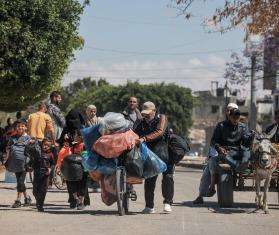A Doctors Without Borders/Médecins Sans Frontières (MSF) tent hospital set up in Guiuan in the aftermath of Typhoon Haiyan is currently the largest medical facility in this devastated region of eastern Samar Island. Ten-year-old Ayron Sanchez was the first child to undergo surgery in the hospital’s inflatable operating theater.
"When Ayron was a little boy of three, he fell from a bridge and his leg got stuck between some wooden planks," says Ruby Sanchez Abendaño, Ayron’s aunt. "Ever since then he has had problems with his left leg."
Abendaño sits outside the inflatable operating theater with Ayron's father, a shy rickshaw driver, who is nervously waiting for his son to come out of surgery. While they wait, Abendaño tells her nephew’s story.
"We were always worried he would lose his leg," she remembers. When Ayron was five, his left thigh started to swell. His parents travelled with him to the Philippine island of Mindoro to see an orthopedic doctor.
"The doctor advised amputation," says Abendaño, "but Ayron’s parents couldn’t afford it, so they went back home." After some time, Ayron’s leg became infected and developed abscesses. Ayron was unable to walk, so his father carried the boy around on his back. "The child was suffering so much," says Abendaño. "He was given antiobiotics, but his leg only got worse and worse."
"Then the typhoon came and destroyed our houses," says Abendaño. The two families, who lived next to door to each other in a small town on the coast of Samar island, sought shelter in a neighbor’s house.
They survived the storm without injury, but, Abendaño says, "The storm took our livelihoods away. We relied on processing coconuts, but now most of the palm trees are destroyed. If we plant new trees now, it will take ten years before we can harvest them."
After the storm subsided, Ayron’s family brought him to Guiuan to have his leg checked by one of MSF’s doctors, who are providing free medical care in the tented hospital there, as well as in a number of rural health centers in the surrounding area. Ayron was admitted immediately.
"The doctor said that he would have to undergo surgery, but that there is no need for an amputation," says Ruby. "We told the doctor we had no money to pay for an operation, but she told us she didn’t need our money. We were so happy."
Three weeks later, after receiving supplementary therapeutic food to build up his strength, Ayron went into surgery. The team working in MSF’s inflatable operating theater is filling the gap left by the destruction of the district hospital which had been the only health facility in the region offering surgical treatment.
Ayron’s operation was a success. Rowena Evangelista, a Filipino surgeon working with the MSF team in Guiuan, says Ayron has a good chance of recovery and will probably be able to walk again—but it will take time.
"He suffered from chronic osteomyelitis, which is an infection of the thigh bone. It was probably caused by a viral infection when he was five, rather than his fall from a bridge," she says. "He will have to stay with us in hospital for at least six weeks to recover, he’ll need to take antibiotics and we will give him more therapeutic food to keep him strong. Finally, Ayron will have to learn to walk again." This is not going to be easy. "He will need special shoes, as his left leg is some centimetres longer than his right leg."
Ayron and his family are prepared for the challenge, says his aunt. "We thought he would lose his leg, but now it has been saved," she says. "The typhoon was a disaster, but this hospital is a blessing."
"In total, five municipalities or 110,000 people depended on this hospital before the storm," says Anne Khoudiacoff, who coordinates MSF's medical activities in Guiuan. "It had a very good reputation, and parts of it had actually just been renewed. The next hospital for referrals is in Tacloban, which is three hours [away] by road and has also been devastated.
"Therefore, we decided to set up a temporary hospital in Guiuan. We started with only a few beds, now we have 60 beds and up to 100 admissions per week. During the first week we carried out six Caesarean sections and surgeries for seven other patients."
MSF is providing medical and humanitarian assistance on three islands that were battered by the typhoon. MSF supports hospitals in Tacloban and Burauen (on Leyte Island), Balasan (on Panay Island), and Guiuan (on Samar Island) with the aim of helping to restore normal medical services as quickly as possible. The support includes repairing damaged buildings; providing medical supplies, drugs and staff; and setting up an ambulance service.





